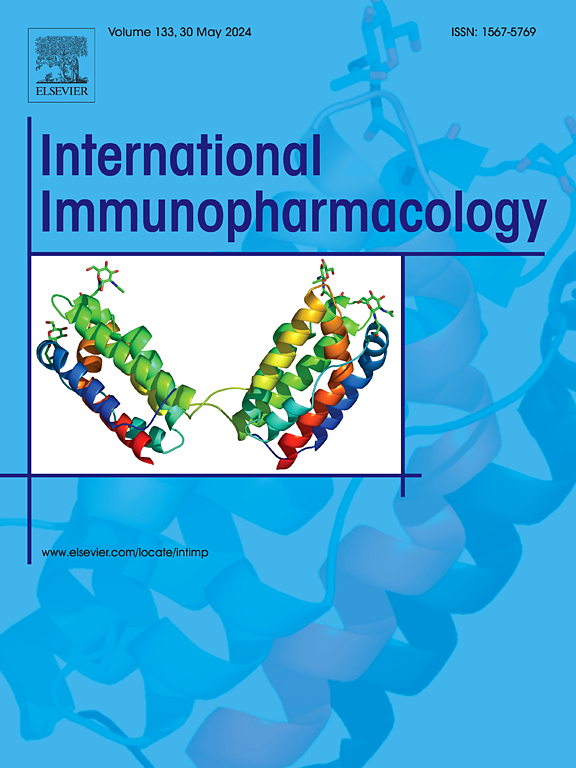S100A9 inhibition ameliorates HFpEF by modulating mitochondrial fission and oxidative stress
IF 4.7
2区 医学
Q2 IMMUNOLOGY
引用次数: 0
Abstract
Heart failure with preserved ejection fraction (HFpEF) is characterized by diastolic dysfunction and myocardial stiffness, with limited treatment options due to the unclear molecular mechanisms underlying the disease. In this study, we investigate the role of S100A9, an inflammatory mediator, in regulating mitochondrial dynamics in HFpEF. Using “two-hit” (high-fat diet and L-NAME) and db/db mouse models, we show that S100A9 is significantly elevated in both cardiac tissue and serum, correlating with impaired diastolic function, cardiac hypertrophy, and increased oxidative stress. Inhibition of S100A9 with Paquinimod (PAQ) improved diastolic function, reduced cardiac hypertrophy, and decreased S100A9-positive macrophage infiltration, while preventing M1 macrophage polarization. In vitro, S100A9 secreted by palmitic acid-stimulated RAW 264.7 macrophages promoted mitochondrial fission in AC16 cardiomyocytes by increasing p-Drp1 and Fis1 expression, similar to the effects observed with recombinant S100A9. Excessive mitochondrial fission, regulated by S100A9, is a key factor in HFpEF progression. Transcriptomic analysis revealed significant upregulation of pyruvate dehydrogenase kinase 4 (PDK4) in HFpEF mice. Mechanistically, S100A9 induced PDK4 expression via SPI1-mediated transcription, exacerbating oxidative stress and mitochondrial fragmentation. PAQ treatment or silencing PDK4/SPI1 in AC16 cells reversed these effects, restoring ATP levels and stabilizing mitochondrial membrane potential. Cardiomyocyte-specific PDK4 knockdown in vivo further ameliorated HFpEF progression without affecting systolic function. These findings highlight S100A9 inhibition as a promising therapeutic strategy for HFpEF by targeting mitochondrial dysfunction through the S100A9/SPI1/PDK4 axis.

抑制S100A9通过调节线粒体裂变和氧化应激改善HFpEF
保留射血分数心力衰竭(HFpEF)的特征是舒张功能障碍和心肌僵硬,由于该疾病的分子机制尚不清楚,治疗选择有限。在这项研究中,我们研究了炎症介质S100A9在调节HFpEF线粒体动力学中的作用。通过“双打击”(高脂肪饮食和L-NAME)和db/db小鼠模型,我们发现S100A9在心脏组织和血清中均显著升高,与舒张功能受损、心脏肥厚和氧化应激增加相关。Paquinimod (PAQ)抑制S100A9可改善舒张功能,减轻心肌肥厚,减少S100A9阳性巨噬细胞浸润,同时阻止M1巨噬细胞极化。在体外,棕榈酸刺激的RAW 264.7巨噬细胞分泌的S100A9通过增加p-Drp1和Fis1的表达促进了AC16心肌细胞的线粒体分裂,与重组S100A9的作用相似。由S100A9调控的过度线粒体分裂是HFpEF进展的关键因素。转录组学分析显示HFpEF小鼠的丙酮酸脱氢酶激酶4 (PDK4)显著上调。机制上,S100A9通过spi1介导的转录诱导PDK4表达,加剧氧化应激和线粒体断裂。PAQ处理或沉默AC16细胞中的PDK4/SPI1可逆转这些作用,恢复ATP水平并稳定线粒体膜电位。体内心肌细胞特异性PDK4敲低进一步改善了HFpEF的进展,而不影响收缩功能。这些发现表明,通过S100A9/SPI1/PDK4轴靶向线粒体功能障碍,抑制S100A9是一种很有前景的HFpEF治疗策略。
本文章由计算机程序翻译,如有差异,请以英文原文为准。
求助全文
约1分钟内获得全文
求助全文
来源期刊
CiteScore
8.40
自引率
3.60%
发文量
935
审稿时长
53 days
期刊介绍:
International Immunopharmacology is the primary vehicle for the publication of original research papers pertinent to the overlapping areas of immunology, pharmacology, cytokine biology, immunotherapy, immunopathology and immunotoxicology. Review articles that encompass these subjects are also welcome.
The subject material appropriate for submission includes:
• Clinical studies employing immunotherapy of any type including the use of: bacterial and chemical agents; thymic hormones, interferon, lymphokines, etc., in transplantation and diseases such as cancer, immunodeficiency, chronic infection and allergic, inflammatory or autoimmune disorders.
• Studies on the mechanisms of action of these agents for specific parameters of immune competence as well as the overall clinical state.
• Pre-clinical animal studies and in vitro studies on mechanisms of action with immunopotentiators, immunomodulators, immunoadjuvants and other pharmacological agents active on cells participating in immune or allergic responses.
• Pharmacological compounds, microbial products and toxicological agents that affect the lymphoid system, and their mechanisms of action.
• Agents that activate genes or modify transcription and translation within the immune response.
• Substances activated, generated, or released through immunologic or related pathways that are pharmacologically active.
• Production, function and regulation of cytokines and their receptors.
• Classical pharmacological studies on the effects of chemokines and bioactive factors released during immunological reactions.

 求助内容:
求助内容: 应助结果提醒方式:
应助结果提醒方式:


